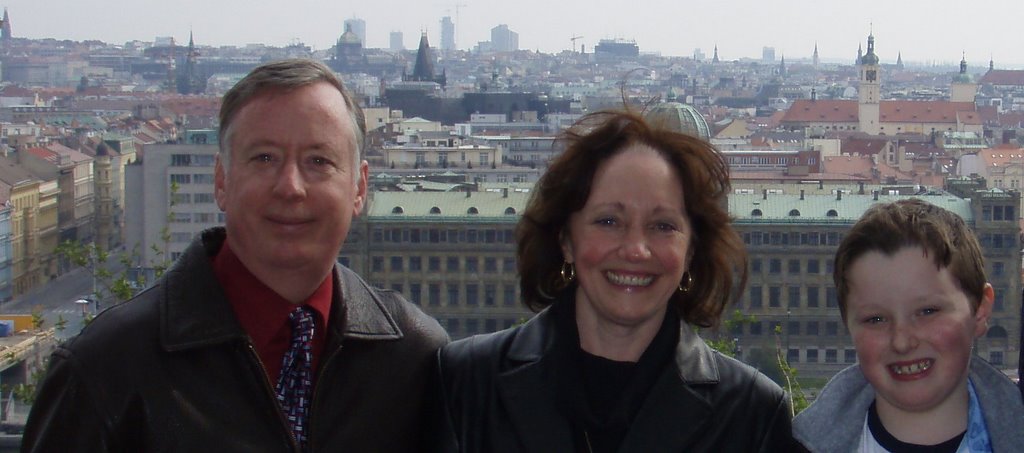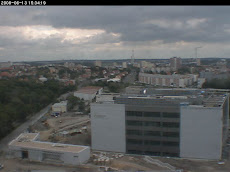I will finish up posting on Terezin today with our visit to the Ghetto Museum.
The Ghetto Museum in Terezin is about a 1/2 mile from the Small Fortess. While nearly all of the buildings within the walls of the old town (the Large Fortess) are from the time of the Jewish Ghetto (late 1941 to May 1945) only one building serves as the museum.
There were a couple of particularly interesting items. First, there is a room with the names of the thousands who perished in the ghetto, which are listed in alphabetical order. Surprisingly, there are two Tischler - Manfred and Ernesta Tischler. I and my cousin Rick have been trying, mostly unsuccessfully, to follow our Tischler line back into Europe. Who knows if Manfred and Ernesta are some long lost relatives.
A stairway in the Ghetto Museum has copies of dozens of drawings from the children of Terezin.
Also, there was a room with dozens of pictures made by the children of Terezin. Thousands of drawings from the children were hidden and found after the war. They were quite moving. Each drawing had the name of the child who created it and thier fate. Most of the children ended up at Auschwitz where they died. Noah went through the drawings looking for the ones that were by children who survived the war. He would call to us when he found one and was happy. I guess it was his way of dealing with magnitude of the suffering of the kids (many his age). Yes, some did survive. 
One of the drawings of life in the ghetto.
Arriving at the ghetto.
Here is a book I think I have ordered from Amazon. It's Fireflies in the dark: the story of Friedl Dicker-Brandeis and the children of Terezin by Susan Goldman Rubin.
From a review of the book: Although this book has the look of a picture book for younger children, the messages contained within are for older readers. Artist Dicker-Brandeis ran secret art classes for children at the Terezin Concentration Camp. She and nearly all of her pupils perished, but 5000 of the drawings and paintings were discovered hidden in a suitcase. Many of those works are found in this book.
Thursday, January 31, 2008
The children of Terezin...
Posted by
Al Tischler
at
9:54 AM
1 comments
![]()
![]()
Labels: Czech Republic, sights, Terezin
Wednesday, January 30, 2008
More on Terezin...
From the web site Jewish Virtual Library:
Hitler, the world was to be told, had built a city for the Jews, to protect them from the vagaries and stresses of the war. A film was made to show this mythic, idyllic city to which his henchmen were taking the Jews from the Czech Lands and eight other countries. Notable musicians, writers, artists, and leaders were sent there for "safer" keeping than was to be afforded elsewhere in Hitler's quest to stave off any uprisings or objections around the so-called civilized world. This ruse worked for a very long time, to the great detriment of the nearly two hundred thousand men, women and children who passed through its gates as a way station to the East and probable death.
The Red Cross was allowed to visit Terezin once. The village of Terezin was spruced up for the occasion. Certain inmates were dressed up and told to stand at strategic places along the specially designated route through Terezin. Shop windows along that carefully guarded path were filled with goods for the day. One young mother remembers seeing the bakery window and shelves suddenly filled with baked goods the inmates had never seen during their time at Terezin. Even the candy shop window overflowed with bon bons creating a fantastic illusion she would never forget.
When the Red Cross representative appeared before this young mother, she remembers being asked how it was to live in Terezin during those days. Her reply implored the questioner to look around. Be sure and look around, as she herself rolled her own widely opened eyes around in an exaggerated manner. The Red Cross reported dryly that while war time conditions made all life difficult, life at Terezin was acceptable given all of the pressures. The Red Cross concluded that the Jews were being treated all right.
There were so many musicians in Terezin, there could have been two full symphony orchestras performing simultaneously daily. In addition, there were a number of chamber orchestras playing at various times. A number of distinguished composers created works at Terezin including Brundibar or the Bumble Bee, a children's operetta and a number of chamber compositions which only now are being resurrected and played in Europe and the United States.
This was not a death camp, by the usual definition. There is no way to compare Terezin to Auschwitz-Birkenau or Treblinka or any of the other death camps where hundreds of thousands were gassed or murdered in other ways each year. Terezin, by comparison was a place to which people would apply so as to avoid a worse fate. 
Leskley painting "Beautified and Phony - Red Cross Inspection"
Eli Leskley's Ghetto Diary (from the University of Minnesota Holocaust and Genocide Studies web site)
Born in 1911, Leskley painted 70 satiric watercolors while he was interned in Terezin, the show camp and ghetto established by the Nazis in Czechoslovakia. He hid them, retrieved them after the war and recreated each one. The paintings are available in sets of 15 or the complete collection of 40. Many of the originals were damaged. Part of those paintings were saved and mounted. Immediately after the war, Leskley repainted all the images to provide a satiric and poignant view of the camp at Theresienstadt.
Posted by
Al Tischler
at
8:47 AM
0
comments
![]()
![]()
Labels: Czech Republic, sights, Terezin
Tuesday, January 29, 2008
Terezin
On Saturday we made the 45 minute drive north of Prague to Terezin. Terezin is most notable for its role in World War II, as the location of a primary Jewish ghetto and for the political prison also there.
The Jewish cemetary just outside the small fortress.
A fort named Terezin, or Theresienstadt in German, was built by the Hapsburgs in the 1780s to protect against the Prussians to the north. During WWI it was used to house prisoners of war.
From Wikipedia:
The Small Fortress was part of the fortification on left side of river Ohře. Since 1940, the Gestapo used it as a prison (the largest one in the Protectorate of Bohemia and Moravia). It was separate and unrelated to the Jewish ghetto in the main fortress on the river's right side. Around 90,000 people arrived there and were usually sent to a concentration camp later. 2,600 people were executed, starved, or succumbed to disease there. A possible 1,100 children survived of the 15,000 sent there.
The 1st gate of the small fortress with the slogan "Work will set you free". Most of those who died here were worked to death as slave laborers.
Noah stands in the hallway of the building that housed the more than 20 cells for solitary confinement. Conditions here were horrendously bad. Only one of these cells was not used by the Nazis during WWII - Cell #1 had housed Gavrilo Princip, the Serb who assassinated Franz Ferdinand, Archduke of Austria and his wife, starting the First World War, and he died here of tuberculosis in 1918. I was able to enter the cell - it was an interesting feeling.
The shower room of the Small Fortress. Noah asked if this is where the Jews "got acid" meaning the poison gas. But Terezin was not an extermination camp. The Terezin ghetto, like all of the Jewish ghettos, was a place to accumulate Jews before deportation to the East for extermination in places like Auschwitz. Terezin was the western most of the Jewish ghettos.
During WWII, the Gestapo used Terezín, better known by the German name Theresienstadt, as a ghetto, concentrating Jews from Czechoslovakia, as well as many from Germany, Austria, the Netherlands and Denmark. Though it was not an extermination camp, of the over 150,000 Jews who arrived there, about 33,000 died in the ghetto itself, mostly because of the appalling conditions arising out of extreme population density. About 88,000 inhabitants were deported to Auschwitz and other extermination camps. At the end of the war there were 17,247 survivors.
Part of the fortification (Small Fortress) served as the largest Gestapo prison in the Protectorate of Bohemia and Moravia, separated from the ghetto. Around 90,000 people went through it, and 2,600 of those died there.
It was liberated on May 9th, 1945 by the Soviet Army.
Posted by
Al Tischler
at
10:51 AM
1 comments
![]()
![]()
Labels: Czech Republic, sights, Terezin





